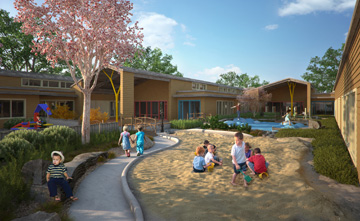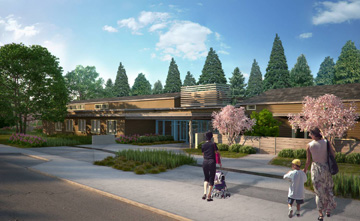Childhood Center Combines Play With Study

VGRESHAM, Ore. — Construction is expected to begin any day now on the Mt. Hood Community College’s Early Childhood Center, a building designed to scale for infants and toddlers in some places, and for observation and academic purposes for collegians and staff in other ares.
Considered the first new construction on the community college’s Gresham campus in 30 years, the center will be operated by and serve as a regional headquarters for Head Start, which is a national child development program run by the U.S. Department of Health and Human Services. The building will also provide a new home for the community college’s early childhood education program and space for approximately 60 college students studying the subject.
The $5.4 million, 23,500-square-foot center was designed by Mahlum Architects of Portland and will be constructed by Chicago-based Walsh Construction. The building is expected complete by the summer of 2011.
"The current program is housed in inadequate facilities," says Kurt Haapala, an associate principal with Mahlum Architects. "It’s in buildings that are temporary facilities which weren’t really designed to support children’s needs."

The new center will feature eight classrooms capable of housing 124 children in half-day sessions. Each classroom will contain low windows that children can easily see out of, as well as 30-inch deep walls with room for storage, window seats, and places where children can crawl and play.
"It’s really important at that age that they develop core competencies – fine and gross motor skills for example," Haapala says. "So we tried to create environments that were good quality indoor environments with good lighting and good comfort.
"The outside play area and interior classrooms are all about experiential-based learning – places where children can crawl up and see the world differently," he adds. "In certain areas, we incorporated in light and shadows, hot and cold, contrasting colors – all of these types of things help small human beings understand the world better. We also designed some of the rooms and equipment to be at their scale, so there are little toilets, little sinks, and little spaces to crawl up on, like balcony windows."
Outdoor play areas, including a "farm" with garden area, will be constructed of soft surfaces. Large windows will provide views into and out of exterior play zones for children. The building will also house a kitchen, where meals for 13 Head Start programs in the Gresham area will be prepared. Children will be able to see into the kitchen and watch staff cook and prepare meals.
"Some kids are passive learners," Haapala explains. "That is to say, if there is an activity going on that they don’t want to participate in and they are off in the distance observing, they are actually participating, just in a different way. So we’ve created these little nooks that actually look out into corridors so kids can crawl in and feel comfortable and safe in the environment and observe teachers working with other children, or teachers working with college students."
The Early Childhood Center was designed with as much an emphasis on observing as it was on playing and learning. College students can view into the windows of the same nooks and crannies their subjects are exploring. Mahlum Architects has also proposed a camera and audio system for the facility, allowing students and faculty to watch children interact from the building’s collegiate classrooms.
"College students will be able to actually use the technology to zoom in and display images of the children on screens in the adult classrooms," says Haapala.
The center will include a family welcome room with fireplace and sofas. The building is expected to earn LEED Silver certification and feature a variety of green elements, including a rooftop solar array, heavily insulated walls, clerestory lighting, and radiant heating in the floors.
